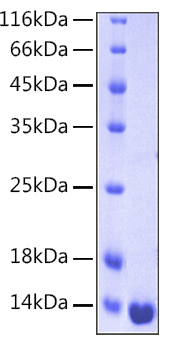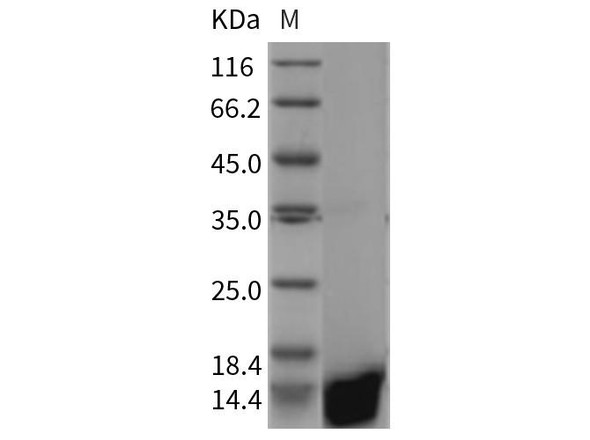Description
Recombinant Human Galectin-1/LGALS1 Protein
The Recombinant Human Galectin-1/LGALS1 Protein is a biologically active recombinant protein that plays a significant role in various cellular processes and signaling pathways in human biology. This protein is widely employed in immunological research, cell biology studies, protein-protein interaction analyses, and therapeutic development, providing researchers with a reliable tool for investigating Galectin-1/LGALS1 function and its implications in health and disease.
This product (SKU: RPCB0160) is produced using E. coli and features a No tag tag for convenient detection and purification. The protein exhibits a calculated molecular weight of 14.58 kDa with an observed molecular weight of 14 kDa under denaturing conditions, achieving ≥ 95 % as determined by SDS-PAGE.. Functional bioactivity has been validated through rigorous quality control assays, confirming its suitability for demanding research applications.
Key Features
| High Purity by Affinity Chromatography | |
| Mammalian & Bacterial Expression Systems | |
| High lot-to-lot consistency via strict QC |
| Product Name: | Recombinant Human Galectin-1/LGALS1 Protein |
| SKU: | RPCB0160 |
| Size: | 10 μg , 20 μg , 50 μg , 100 μg |
| Reactivity: | Human |
| Synonyms: | GAL1, GBP, LGALS1, GAL1, galectin-1, GBP, Galectin 1/LGALS1 |
| Tag: | No tag |
| Expression Host: | E. coli |
| Calculated MW: | 14.58 kDa |
| Observed MW: | 14 kDa |
| Gene ID: | 3956 |
| Protein Description: | High quality, high purity and low endotoxin recombinant Recombinant Human Galectin-1/LGALS1 Protein (RPCB0160), tested reactivity in E. coli and has been validated in SDS-PAGE.100% guaranteed. |
| Endotoxin: | < 0.1 EU/μg of the protein by LAL method. |
| Purity: | ≥ 95 % as determined by SDS-PAGE. |
| Formulation: | Lyophilized from a 0.22 μm filtered solution of PBS, pH 7.4.Contact us for customized product form or formulation. |
| Bio-Activity: | Measured by its ability to agglutinate mouse red blood cells. The ED 50 for this effect is 0.5-3 μg/mL. |
| Reconstitution: | Centrifuge the vial before opening. Reconstitute to a concentration of 0.1-0.5 mg/mL in sterile distilled water. Avoid vortex or vigorously pipetting the protein. For long term storage, it is recommended to add a carrier protein or stablizer (e.g. 0.1% BSA, 5% HSA, 10% FBS or 5% Trehalose), and aliquot the reconstituted protein solution to minimize free-thaw cycles. |
| Storage: | Store at -20℃.Store the lyophilized protein at -20℃ to -80 ℃ up to 1 year from the date of receipt. After reconstitution, the protein solution is stable at -20℃ for 3 months, at 2-8℃ for up to 1 week. |
Galectin-1, also known as LGALS1 (lectin, galactoside-binding, soluble 1), is a 135 amino acid (aa), 14 kDa, pleiotropic, Non-glycosylated, monomeric or homodimeric carbohydrate-binding protein of the prototype galectin family. Galectins lack a classical signal peptide and can be localized to the cytosolic compartments, or secreted by non-classical pathways. Secreted Galectin-1 has immunosuppressive and anti-inflammatory properties and suppresses acute and chronic inflammation and autoimmunity. It contributes to negative selection of developing T cells, immunosuppression by regulatory T cells, resolution of the inflammatory response, and inhibition of immune cell migration, inflammatory cytokine production, and mast cell degranulation. Galectin-1 contributes to different steps of tumour progression including cell adhesion, migration and tumour-immune escape, suggesting that blockade of galectin-1 might result in therapeutic benefits in cancer. Several potential glycoprotein ligands for galectin-1 have been identified, including lysosome-associated membrane glycoproteins and fibronectin, laminin, as well as T-cell glycoproteins CD43 and CD45. Evidence points to Gal-1 and its ligands as one of the master regulators of such immune responses as T-cell homeostasis and survival, T-cell immune disorders, inflammation and allergies as well as host-pathogen interactions.








